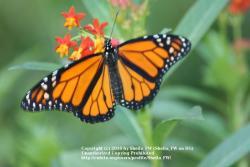Bt-corn is killing Monarchs too.
http://www.ca.uky.edu/entomolo...
Bt-corn is a type of genetically modified organism, termed GMO. A GMO is a plant or animal that has been genetically modified through the addition of a small amount of genetic material from other organisms through molecular techniques.
A donor organism may be a bacterium, fungus or even another plant. In the case of Bt corn, the donor organism is a naturally occurring soil bacterium, Bacillus thuringiensis, and the gene of interest produces a protein that kills Lepidoptera larvae, in particular, European corn borer. This protein is called the Bt delta endotoxin. Growers use Bt corn as an alternative to spraying insecticides for control of European and southwestern corn borer.
The protein is very selective, generally not harming insects in other orders (such as beetles, flies, bees and wasps). To kill a susceptible insect, a part of the plant that contains the Bt protein (not all parts of the plant necessarily contain the protein in equal concentrations) must be ingested. Within minutes, the protein binds to the gut wall and the insect stops feeding. Within hours, the gut wall breaks down and normal gut bacteria invade the body cavity. The insect dies of septicaemia as bacteria multiply in the blood. Even among Lepidoptera larvae, species differ in sensitivity to the Bt protein.
my comments:
Growing up in Iowa, we often saw big patches of milk weed growing in the ditches next to the gravel roads, which by the way, border-on the corn fields. Butterflies were common and driving down the hiway in the country at 75MPH you would collect specimens plastered on the front of your car radiator, and usually get home with a monarch or two. Why have they dissappeared? Farmers have new chemicals effective on killing "weeds" so there is a lot less milkweed.
BT Corn makes pollen in July that scatters in the wind, and especially thick pollen collects in those ditches where the milk weed grow best. What do you think happens when the pollen from the corn tassels sticks to the fuzzy leaves of the milk weed? NO MORE WORMS on the milk weed.
pic shows typical Iowa landscape with corn tassel in bloom next the the road ditch.


